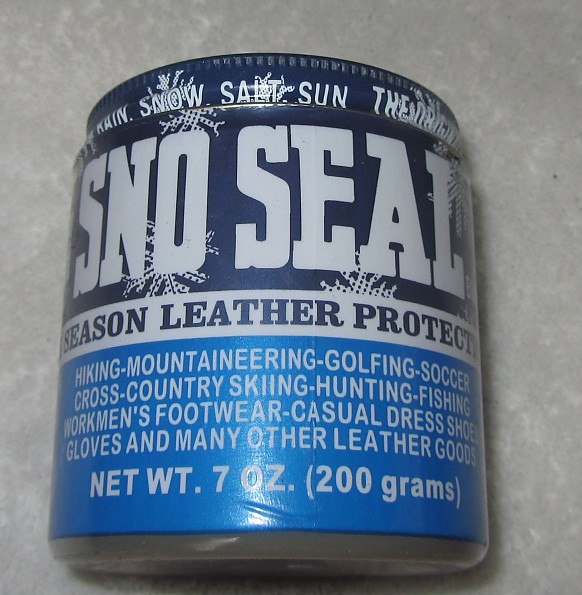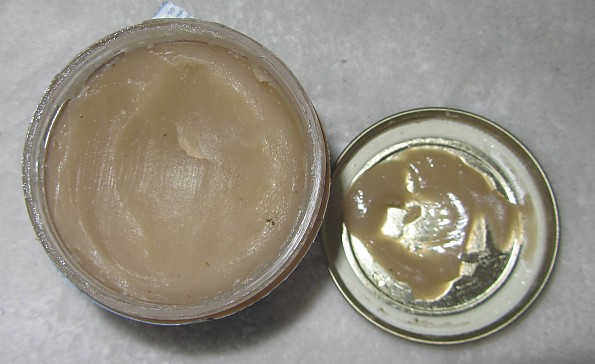Atsko Sno-Seal

Beeswax based leather treatment. Waterproofs and conditions leather. Great for boots, motorcycle leathers and other gear exposed to the elements.
Pros
- Waterproof within reason
- Easy to apply
- No smell after drying
Cons
- May change leather color
- Over treated leather is a dust magnet
Sno-Seal has been my go-to leather treatment for decades primarily on leather boots and motorcycle jackets. The beeswax based product is listed by Atsko as suitable for waxed cotton and for tent seams, but I have never used it for those purposes.
In my experience the product is best applied to warm leather as heat softens the wax and makes it easier to apply evenly. I usually put items to be treated in the sun for a few minutes first after brushing and/or wiping them down to remove any dirt. Using just enough to coat the leather, but not leaving visible excess on the surface I gently work the product into the leather paying special attention to the seams. After allowing some drying time if any excess remains on the surface I wipe it off to avoid dust attraction.
According to the manufacturer, the beeswax lubricates the leather enough to keep it from drying out, but without deep penetration that would over soften. They say that it will not interfere with a breathable membrane such as Gore-Tex liners as only the outer surface of the leather is waterproofed. That leaves the inner side of the leather to absorb moisture through the Gore-Tex and then pass it back through the membrane as boots dry overnight.
I have used Sno-Seal on combat boots, hiking boots, motorcycle jackets as well as leather gloves and even belts. Beyond the waterproofing I find it to really help preserve leather. I spent a few decades riding and hiking in Southern California exposing gear to high heat and low humidity as well as winter rains. This product kept leather gear pliable enough to not crack but still firm enough to hold its shape and retain surface strength to prevent scratches and gouges. Since moving to Maine I don't see desert conditions but have added snow and road salt into the mix along with lots more mud. Sno-Seal continues to deliver in these conditions.
While I haven't found anything that works better for me I do have to note that after a few days of constant soaking water does eventually get into the leather. My feet will not be completely soaked, but I have noticed when the dampness would begin to reach my socks. These are times of hiking in ankle deep water for hours or constant pouring rain, but the product is not fail proof.
Two things should be noted if using this product. As with any leather treatment it should be tested on an unseen area first to determine how it will affect color as it may darken it somewhat. The other is that if you are not careful to remove all extra wax from items it will act as a dust magnet and if larger amounts are left behind it can liquify in high heat which can be messy.
Over all I have been very pleased with this product which is why I have continued to use it for so many years. I use silicone spray and mink oil for some purposes, but Sno-Seal's beeswax is a leather treatment and waterproofer which I can definitely recommend.
Source: bought it new
Price Paid: $7
For chrome-tanned boots, I've never found anything better to keep the water out.
Pros
- With constant use, bomber waterproofing
- Easy to apply, even moisturizes your skin
Cons
- Need patience in applying
It's hard to beat LoneStranger's review of Sno-Seal! I've only used it on my hiking and climbing boots, so I can't testify to its use on belts and jackets. If it's as good on these other applications as it is on boots, It must be greater than I even thought.
I started using Sno-Seal in the mid '60s when I got into serious mountaineering — this really was the only thing available besides silicone liquids which were known to be detrimental to chrome-tanned leather. In the mid- to late-'70s several other companies introduced new products that were to (and still do) compete with Sno-Seal. I've tried them, unsuccessfully, and each time returned to Sno-Seal.
Application
When I first used Sno-Seal, I made the same mistake I'm sure most first-time users do — I put on too much, trying to get the job done quickly. The result was a sticky mess, being very difficult to remove the excess, and the resultant goop picked up all dust and anything that would stick.
The trick to using Sno-Seal is to use only a little at first, wait for it to sink in (measured in days, not hours), and then re-apply a few more times — again a little at a time. Once no more can be applied, wear the boots until they need another coat. Then, again, start slowly. After an extended time of many applications, the boots will be waterproof such that water won't get in.
A lot of people recommend heating the boots before application. While this does work, there is a very thin line between enough heat and destroying the boots. Having watched two of my friends ruin their new, and expensive, boots by accidentally applying too much heat, I avoid using heat.
As LoneStranger stated, Sno-Seal will darken leather, especially with prolonged use. While I think this darkening adds character to the boots, some people will find it objectionable.
Results
At the initial applications, the boots are fairly waterproof — if you don't try crossing streams or tramp across deep snow. However, the longer you diligently continue to use Sno-Seal, the more waterproof the boots become, yet they still stay flexible and don't feel like you are wearing plastic bags. After a while (a time measured in months and years), you no longer worry about the stream crossing or staying on snow for the whole day.
Recommendation
I, personally, recommend Sno-Seal for any chrome-tanned leather. As I have no experience in products using vegetable-tanned leather, I can't make a recommendation pro or con for this kind of leather.
Source: bought it new
Price Paid: Less than $4 to more than $10 over the years
Your Review
Where to Buy
You May Like
Specs
| Price |
Current Retail: $6.49-$6.99 Historic Range: $3.99-$8.99 Reviewers Paid: $7.00 |







